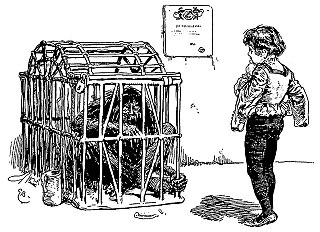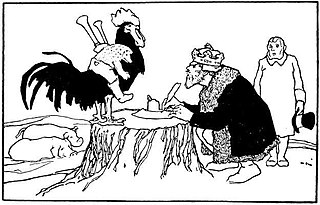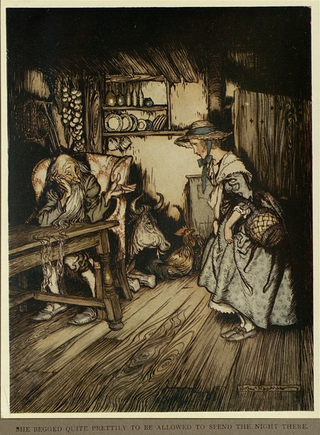Related Research Articles

"Iron John" is a German fairy tale found in the collections of the Brothers Grimm, tale number 136, about an iron-skinned wild man and a prince. The original German title is Eisenhans, a compound of Eisen "iron" and Hans. It represents Aarne–Thompson type 502, "The wild man as a helper".
The Aarne–Thompson–Uther Index is a catalogue of folktale types used in folklore studies. The ATU Index is the product of a series of revisions and expansions by an international group of scholars: originally composed in German by Finnish folklorist Antti Aarne (1910), the index was translated into English, revised, and expanded by American folklorist Stith Thompson, and later further revised and expanded by German folklorist Hans-Jörg Uther (2004). The ATU Index, along with Thompson's Motif-Index of Folk-Literature (1932) – with which it is used in tandem, is an essential tool for folklorists.

"Hans My Hedgehog" is a German fairy tale collected by the Brothers Grimm. The tale was translated as Jack My Hedgehog by Andrew Lang and published in The Green Fairy Book. It is of Aarne-Thompson type 441.

The Three Heads in the Well is a fairy tale collected by Joseph Jacobs in English Fairy Tales.
The Giant Who Had No Heart in His Body is a Norwegian fairy tale collected by Asbjørnsen and Moe.
"Thirteenth" is an Italian fairy tale originally collected by Sicilian folklorist Giuseppe Pitrè and published by Thomas Frederick Crane in Italian Popular Tales. It is Aarne-Thompson type 328, "The Boy Steals the Giant's Treasures".
The Grateful Beasts is a Hungarian fairy tale collected by Georg von Gaal in Mährchen der Magyaren (1822). The tale was also published by Hermann Kletke in Märchensaal, Vol II (1845).

"The Hut in the Forest" is a German fairy tale collected by the Brothers Grimm. Andrew Lang included it in The Pink Fairy Book (1897). It is Aarne-Thompson type 431.
"The Three Little Birds" is a German fairy tale collected by the Brothers Grimm, tale number 96. The story is originally written in Low German. It is Aarne-Thompson type 707, the dancing water, the singing apple, and the speaking bird. The story resembles Ancilotto, King of Provino, by Giovanni Francesco Straparola, and The Sisters Envious of Their Cadette, the story of the 756th night of the Arabian Nights.
"The Pig King" or "King Pig" is an Italian literary fairy tale written by Giovanni Francesco Straparola in his The Facetious Nights of Straparola. Madame d'Aulnoy wrote a French, also literary, variant, titled Prince Marcassin.
The Ram is a French literary fairy tale by Madame d'Aulnoy.
Prunella is an Italian fairy tale, originally known as Prezzemolina. Andrew Lang included it in The Grey Fairy Book. It is Aarne-Thompson type 310, the Maiden in the Tower.
Conall Cra Bhuidhe or Conall Yellowclaw is a Scottish fairy tale collected by John Francis Campbell in Popular Tales of the West Highlands.
The Daughter of the Skies is a Scottish fairy tale collected by John Francis Campbell in Popular Tales of the West Highlands, listing his informant as James MacLauchlan, a servant from Islay.
The Three Daughters of King O'Hara is an Irish fairy tale collected by Jeremiah Curtin in Myths and Folk-lore of Ireland. Reidar Th. Christiansen identified its origin as Co. Kerry.
"Thumbling," published in German as "Daumesdick" is a German fairy tale collected by the Brothers Grimm in Grimm's Fairy Tales in 1819. The Grimms included another, similar story, "Thumbling's Travels." Both stories are related to the English Tom Thumb and often share its title when translated into English.

"The Three Feathers" is a story by the Brothers Grimm, in their Kinder- und Hausmärchen. It is KHM nr. 63. It is classified as Aarne–Thompson–Uther ATU 402, "The Animal Bride". A second variant of the tale also collected by the Brothers Grimm is "The Poor Miller's Boy and the Cat", listed as KHM 106.
In folkloristics, "The Animal as Bridegroom" refers to a group of folk and fairy tales about a human woman marrying or being betrothed to an animal. The animal is revealed to be a human prince in disguise or under a curse. Most of these tales are grouped in the international system of Aarne-Thompson-Uther Index under type ATU 425, "The Search for the Lost Husband". Some subtypes exist in the international classification as independent stories, but they sometimes don't adhere to a fixed typing.
Sigurd, the King's Son is an Icelandic fairy tale collected and published by author Jón Árnason. It is related to the international cycle of the Animal as Bridegroom or The Search for the Lost Husband, wherein a human princess marries a prince under an animal curse, loses him and has to search for him.
References
- 1 2 3 Ashliman, D. L. (2008). "War between Wild Animals and Domestic Animals". University of Pittsburgh.